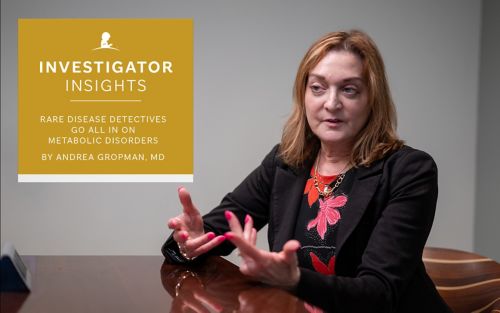St. Jude Family of Websites
Explore our cutting edge research, world-class patient care, career opportunities and more.
St. Jude Children's Research Hospital Home

- Fundraising
St. Jude Family of Websites
Explore our cutting edge research, world-class patient care, career opportunities and more.
St. Jude Children's Research Hospital Home

- Fundraising
Rare disease detectives go all in on metabolic disorders

Andrea Gropman, MD, had always gravitated toward patients affected by metabolic pathway deficiencies that manifest as disease. She now brings that expertise to the Pediatric Translational Neuroscience Initiative at St. Jude.
Rare disease research needs a Sherlock Holmes — someone to help children and their families affected by these disorders understand the biology behind their symptoms and figure out a way forward. I’ve spent my career trying to be that investigator, seeking out patterns within unexplained diseases. Having recently joined the Pediatric Translational Neuroscience Initiative (PTNI) here at St. Jude, my colleagues and I are all in on piecing together parts of the rare disease puzzle and solving mysteries that confound treatment.
My research, in particular, focuses on metabolomics, something I was drawn to early in my career. I received dual fellowship training in child neurology and metabolic genetics but still gravitated toward patients affected by metabolic pathway deficiencies that manifest as disease. Metabolism is the series of chemical changes that occur in the body to produce energy and the basic materials needed to sustain life. Metabolic pathways are the connected chains of chemical reactions that drive metabolism. Two-thirds of metabolic disorders involve the nervous system, but these are rare and somewhat mysterious conditions.
When I began my career, nobody knew what kind of storm was going on in patients’ brains when they would experience metabolic crashes (a sharp decrease in energy production rates). These patients would have seizures or fall into a coma, and it was unclear why. But I wanted to find out. Today, as leader of Neurometabolic Translational Research at St. Jude, I know we can make a difference for these patients, establishing our program as an authority in the research and care of these disorders.
A patient-focused approach to research
One of the most important lessons I’ve learned in my career is something we’re bringing directly into our work at St. Jude. It stems from the early research I did on urea cycle disorders. The urea cycle is supposed to break down and handle the ammonia from the recycling of proteins in your body. If you have too much ammonia, it can get into the brain and cause a change in your level of consciousness, triggering seizures, comas and even death. My team and I learned so much from patients with these disorders, but the most important is, perhaps, how we learned to approach research on rare diseases: you must listen to patients’ stories to know what your next line of research should be.
For our urea cycle research, this was especially true when I noticed, through a focus group of adult patients, a trend of difficulties with driving, not wanting to drive and general visual, spatial and attentional issues. In response, we built a driving simulator and used some of our noninvasive imaging tools, including functional near-infrared spectroscopy (fNIRS), to see what was happening in their brains while driving. We gave them decisions they had to make and determined the viability of these tools to explore the brains of people with urea cycle disorders and the pathways activated in them during tasks such as driving.
The imaging technology we used in this early work is something that we’re bringing to our new laboratory at St. Jude. This will complement the in-scanner multimodal imaging work we have done, which demonstrated a characteristic brain biochemical status, as well as microscopic changes in the brain’s white matter tracks. This new project, with its noninvasive approach, will provide invaluable insights not just to my own research but also to other research groups investigating childhood cancer survivorship and sickle cell disease. From simply listening to patients and trying to better understand the challenges they were encountering in their daily lives, we were able to use and develop a technology that today is applicable to a wide range of disorders affecting the brain, cognition and executive function. Innovation comes from centering patients and their concerns in research questions.
Leading the way in neurometabolic research
This lesson in the importance of centering patients in our research shapes another of our initiatives in Neurometabolic Translational Research: designing clinical trials for rare diseases. We know that there are patients who are suspected of having a type of metabolic disease but still struggle to get a more precise diagnosis about what is happening biologically to drive their symptoms. We want to draw on metabolomics and other omics techniques beyond standard gene sequencing to help give those patients a diagnosis.
At St. Jude, we can combine this omics-based approach with advanced imaging technologies to search for novel biomarkers. The combined process of studying these patients in-depth would be revolutionary for rare disease clinical trials and outcome measures. For the first time in my research career, we now have an opportunity to think about the therapeutics aspect of rare disease research.
I have always been a proponent of team science, but here at St. Jude, we have access to cross-disciplinary experts whose perspectives we can bring to bear on the problem of rare metabolic disease research. We will look at these research questions in different ways and from different angles, charting new ground in understanding and treating these disorders. With patients at the center of our efforts and an unparalleled team approach, we will unravel the mystery of metabolic disease. I can’t wait to see what we discover.






